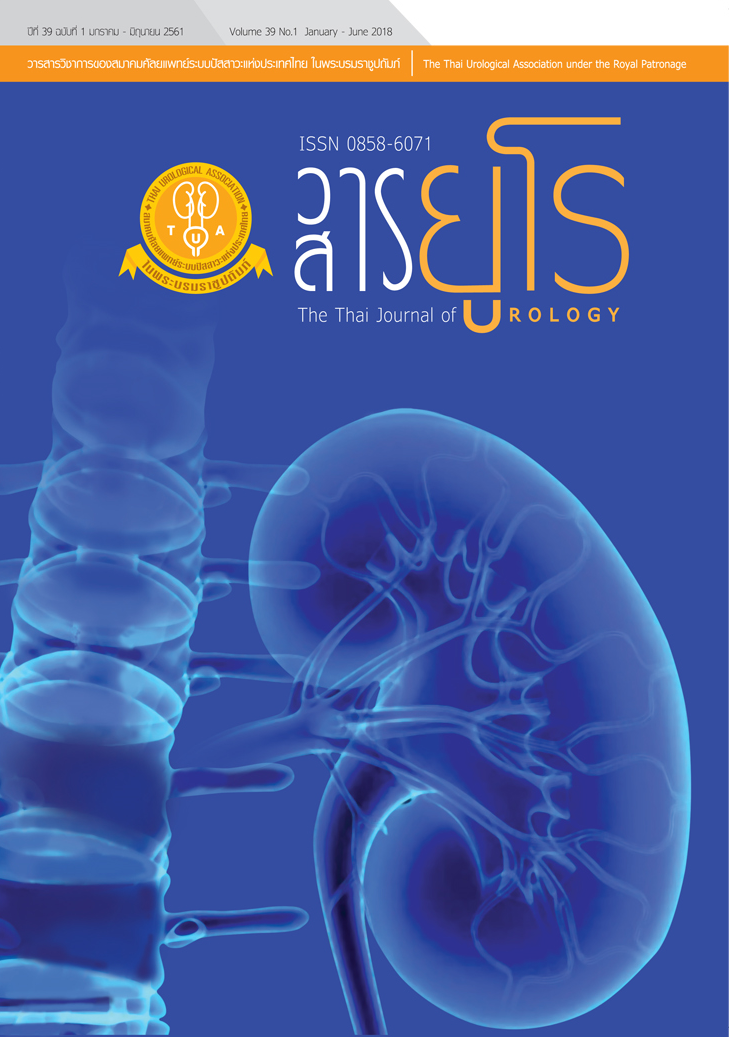Suture flap fixation reduces lymphatic drainage after inguinal node dissection in penile cancer patients
Abstract
Objective: This study assessed the impact of the suture flap fixation technique in decreasing the time to drain removal and wound complications in penile cancer patients undergoing inguinal lymph node dissection.
Material and method: This study assessed (n=58) the surgical sites of penile cancer patients who underwent inguinal lymph node dissection for squamous cell carcinoma of the penis between 2011 and 2016 in Buriram Hospital. The study compared with the suture flap fixation technique in which the skin flap is sutured to the fascia at the floor of the operative site with standard inguinal lymph node dissection. At the end of the procedure a closed suction drain was routinely placed in the groin. The primary outcome was to compare the time to drain removal in both groups.
Result: A total 58 surgical sites of surgical lymph node dissection using the suture flap fixation technique (n=31) and the standard inguinal lymph node dissection only (n=27) were enrolled. Mean duration of time to drain removal was significantly reduced in the suture flap fixation technique group compared with the standard technique only group (5.9+2.6 days versus 8.7+3.1 days p 0.001). No statistically significant differences were observed for operative time and the following postoperative complications: infection, seroma formation, and skin flap problems in the two groups.
Conclusion: Suture flap fixation technique resulted in a significant reduction in the time to drain removal of inguinal lymph node resection in penile cancer patients
References
2. Gie MM, Gie O, Deretti S, et al. Prospective randomized study to compare lymphocele and lymphorrhea control following inguinal and axillary therapeutic lymph node dissection with or without the use of an ultrasonic scalpel. Ann Surg Oncol 2016;23:1716-1720.
3. Purushotham AD: Management of the axilla in operable breast cancer treated by breast conservation: a randomized clinical trial. Br J Surg 2000;87(7):969-970.
4. Kuroi K, Shimozuma K, Taguchi T, Imai H, et al.Effect of mechanical closure of dead space on seroma formation after breast surgery. J Breast cancer 2006;13(3):260-265.
5. Bastelaar J, Beckers A, Snoeijs M, et al. Flap fixation reduces seroma in patients undergoing mastectomy: a significant implication for clinical practice. World J Surg Oncol 2016;14: 66-70.
6. Stuivier MM, Westerduin E, Meulen S, et al. Surgical wound complications after groin dissection in melanoma patients- A historical cohort study and risk factor analysis. EJSO 2014;40:1284-1290.
7. Stuiver MM, Djajadiningrat RS, Graafland NM, et al.Early wound complications after inguinal lymphadenectomy in penile cancer: a historical cohort study and risk-factor analysis. Eur Urol 2013;64:486-492.
8. Sharp DS, Angermeier KW. Surgery of penile and urethral carcinoma. In: Wein AJ, Kavoussi LR, Partin AW, Peter AC, editor. Campbell-Walsh Urology 9th ed. Philadelphia: Elsevier Saunders 2007; p.993-1022.
9. Ray MD, Garg PK, Jakhetiya A, et al. Modified skin bridge technique for ilio-inguinal lymph node dissection: A forgotten technique revisited. World J Methodol 2016;6:187-189.
10. Sakkary MA. The value of mastectomy flap fixation in reducing fluid drainage and seroma formation in breast cancer patients. World J Surg Oncol 2012;10:8-13.
11. Bastelaar J, Roozendaal L, Granzier R. A systematic review of flap fixation techniques in reducing seroma formation and its sequelae after mastectomy. Breast Cancer Res Treat 2018;167:417-423.



